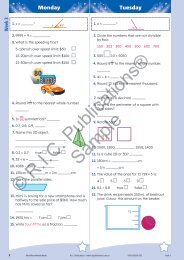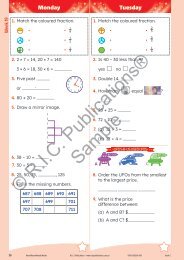You also want an ePaper? Increase the reach of your titles
YUMPU automatically turns print PDFs into web optimized ePapers that Google loves.
Australia’s climate <strong>zones</strong><br />
Lesson objectives<br />
XXExamining climate data from cities/towns in Australia and comparing these to Australia’s climate zone map<br />
XXIdentifying some factors that influence local climate, such as proximity to major lines of latitude and waterways,<br />
elevation or altitude, and natural and built features<br />
Lesson plan<br />
Introduction<br />
XXAs a class, watch the video at to<br />
revise weather and climate and introduce local climate. Discuss the<br />
questions What is the difference between major climate <strong>zones</strong> and<br />
local climate? What factors may influence local climate? (proximity<br />
to major lines of latitude and waterways, elevation/altitude, and<br />
natural/built features)<br />
Development<br />
XXDivide the class into eight groups and allocate a different state<br />
or territory of Australia to each group. As a group, students use<br />
Google Earth to locate and explore their allocated state/territory,<br />
it’s capital city and three major towns. Students then decide who<br />
will research the capital city and who will research each major<br />
town. Individually, students use page 35 to research climate data<br />
for their city/town and record it using the tables.<br />
XXUsing a brainstorming app (Popplet) students write and research<br />
five questions about the elevation and natural and built features in<br />
their city/town and record the answers using the same app.<br />
XXAs a group, students discuss the climate data, location, elevation<br />
and features for each city/town to draw conclusions about the<br />
weather, seasons and climate in that state or territory. Students<br />
then use a presentation app (SeeSaw) to explain the weather and<br />
climate in their allocated state or territory, and factors that may<br />
influence this. Students must add climate data tables (page 33) and<br />
an explanation of the weather, seasons and climate in each city.<br />
Students upload their presentation and view others.<br />
Conclusion<br />
XXAs a class, explore annual temperature and rainfall maps for<br />
Australia at and compare these to<br />
Australia’s climate zone map at .<br />
Think-pair-share What factors may influence the climate in your<br />
researched city/town and in your allocated state/territory?<br />
Resources<br />
XXVideo—What are climate <strong>zones</strong>?<br />
<br />
XXGoogle Earth<br />
XXPage 35<br />
XXiPad ® /tablet with QR scanner, a<br />
brainstorming app (Popplet) and a<br />
presentation app (SeeSaw)<br />
XXAnnual temperature and rainfall maps<br />
of Australia <br />
XXAustralia’s climate zone map<br />
<br />
Travelling further<br />
Students research weather<br />
and climate data for their<br />
local area and create graphs<br />
showing average monthly<br />
temperature and rainfall data.<br />
Students create a model<br />
of their local area and use<br />
climate facts and opinions<br />
to create a stop-motion<br />
animation of the weather<br />
and seasons in their local<br />
area, and how this influences<br />
people’s daily lives.<br />
Curriculum links<br />
HASS Knowledge and Understanding<br />
The main climate types of the world and the similarities and differences between the climates of different places<br />
(ACHASSK068)<br />
HASS Inquiry and Skills<br />
Questioning Researching Analysing<br />
Evaluating and<br />
reflecting<br />
Communicating<br />
• Poses questions about the<br />
elevation and features of a<br />
given city<br />
• Locates and collects<br />
information from Google<br />
Earth, climate maps,<br />
websites and videos<br />
• Records, sorts and<br />
represents data using tables<br />
and a brainstorming app<br />
• Interprets cartographic<br />
information on maps to<br />
locate and explore places in<br />
Australia<br />
• Compares climate and<br />
physical maps to identify<br />
patterns between climate<br />
data and factors that<br />
influence climate<br />
• Draws simple conclusions<br />
about the weather and<br />
climate in a given state/<br />
territory, and factors that<br />
may influence this climate<br />
• Communicates<br />
understanding using a<br />
presentation app<br />
34Y<strong>Year</strong> 3A AC GLOBAL GEOGRAPHYw www.ricpublications.com.auI


















